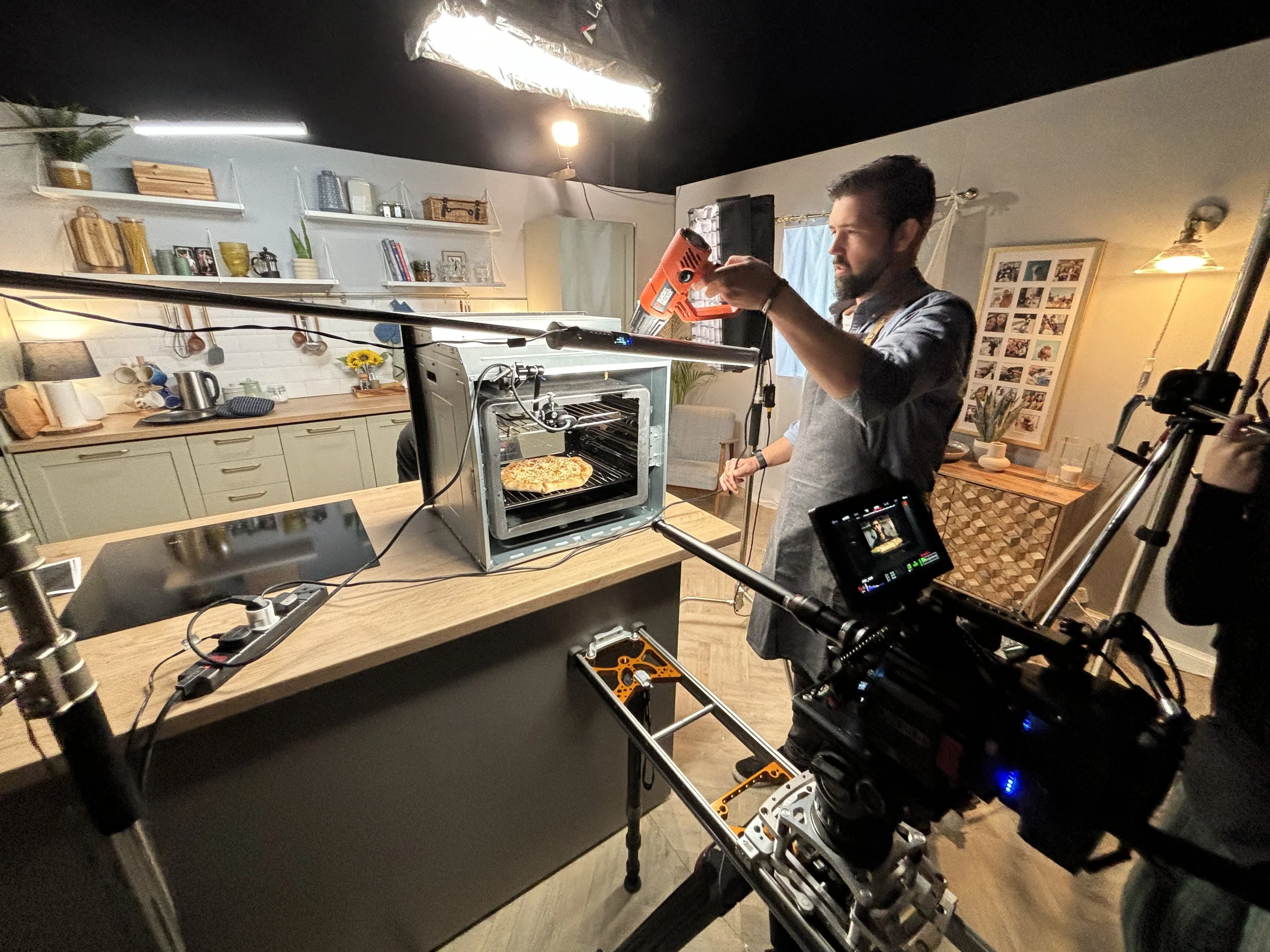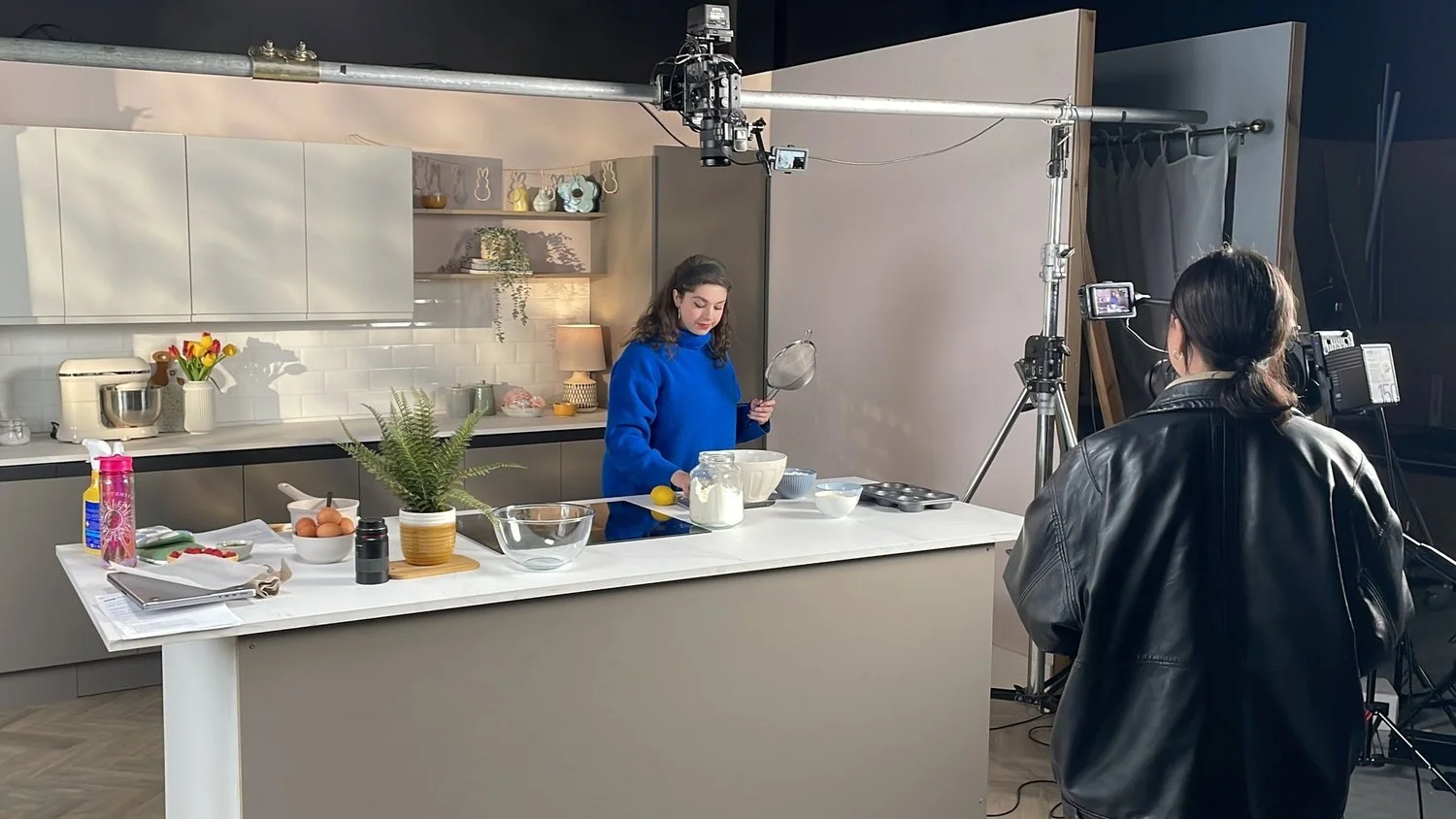The 'One Off' vs. Monthly content & costs involved
The brand film, the TV commercial & the online ad are typically ‘one off’ campaigns. Something a brand may do a handful of times a year with a key message, product or service attached. I’m going to talk about the production behind them and the budgets involved. But more on that later.
But first here’s an example to give you a flavour of what I mean:
Example 1: YouTube pre-roll ad | Mr Kipling
This 20s YouTube ad was created in October 2024 to run throughout the festive period. It was a 1 day shoot in our studio using a team of 10 specialist crew and equipment. The purpose was to stay top of mind with the Mr Kipling customers with the aim to sell more mince pies. The ad reached 4million people on Youtube alone in a targeted media campaign.
Example 2 : Brand Film | Manchester Met University.
2 weeks planning, 3 days filming, 2 weeks editing (allowing for client feedback, not 2 weeks staring at a computer monitor) all coming together in a slick 90s brand film with 76,000 views on the university youtube channel.
The purpose of this brand film was to showcase the facilities of the brand new multi-million pound Dalton building to stakeholders, investors and potential students.
Example 3: Cinema Ad | The Pizza Company
The next is a Cinema ad played out across thousands of screens over an 8 week period for The Pizza Company. The purpose of this ad is to raise brand awareness ultimately selling more pizzas to new and existing customers.
This was 4 weeks worth of planning, 2 days filming and 3 weeks post production. A large professional film crew plus actors were needed to pull this off on time and on budget.
The problem?
It’s very difficult, time consuming and costly to plan, create, deliver and monitor a campaign of this scale every month. That’s why brands tend to do it a few times a year. You could also run the risk of saturating the market or annoying your customer if a new ad was launched too frequently.
Behind the scenes with BBC Food | Recipe video content
But how does this differ from a monthly content retainer?
A content retainer (in the world of video & photography production) is a regular sets of assets of a similar, repeatable theme that can be created and shared with your audience.
An example of this is what we did for BBC Food and are now doing for friends, Ooni. For BBC Food, we would plan, shoot and edit 8 x new recipe videos EVERY single month. That gave their social team 2 slick videos every week to share to their 1.2M strong instagram audience constantly staying top of mind. We delivered 72 different recipe videos over a 9 month period mixing in seasonal treats such as Halloween cakes, Christmas puddings & Diwali meals.
The whole process was continuous, meaning when the production team were filming, the editors were piecing together last months edits whilst the creatives were working on next months recipes. It was like a well-oiled factory line of video content.
A content retainer has to work financially for the brand buying it and the business delivering it. And the way we do that is bulk content creation. We plan for a few days and then film the videos over a 1-2 day period with a multi-skilled team and edit them over a week. We try to be reactive to trends or plan for seasonal content where possible.
Retainer content example:
Here is an example of one of the recipe videos we created. It’s a delicious grapefruit cake featuring baking influencer, Liberty. We produced a landscape version made for the BBC Food website and a vertical version for their social channels using a 2 camera setup in our studio.
But how much does it all cost?
The bit you really want to know. The budgets for a one off campaign vs a monthly retainer.
Behind the scenes with Life Fitness
A video campaign can vary from a one day production to a full week of filming. Prices can flex from £15k - £100k depending on:
The scale of the idea,
The amount of pre-production time,
Number of filming days,
Number of skilled crew involved,
Technical equipment needed,
Talent involved,
Props, costumes and sets,
Post production time,
Any special effects required and much more
This is why it’s almost impossible to answer to question. “How much for a video?” but hopefully that bracket can help at least a bit. £100k might be on the lower end of the budget range when introducing celebrities into the mix but that’s a topic for another time.
Content retainers usually involve a smaller in-house squad. For recipe videos, we require:
a chef/ food stylist,
a producer,
a videographer
and an editor.
4 team members working in tandem to deliver content in 16x9, 9x16, 1x1 and 4x5 formats. Budgets range from £5-12k per month.
Pros
Some of the more obvious pros of this approach include regular assets to stay top of mind to your online audiences & utilising the same production team each month who are fully immersed in the brand and constantly striving for better. You’re not starting at 0 every month.
Cons
Limited monthly budget means we have to be resourceful and realistic with what we’ve got. Large PR stunts or big set pieces remain with the one off project and not something easily done every month. There are smart ways to roll over budget to the next month if you want to do something bigger. Almost like a savings post to the deploy when the timing is right.
Summary
In my opinion there’s no one- size-fits-all solution when it comes to marketing strategy and content creation in 2025. And there’s absolutely a place for well-produced video campaigns with a media budget behind them as well as more regular monthly content. I thought I’d just share the differences between the two and how we have delivered both for a range of clients over the years.
P.s.
I’ve only given one type of content retainer so far. I’m sure there’s plenty of different types of retainer that work well. They could be small product ads on coloured backgrounds or models wearing new clothing items for example. I’ve just used recipes and food because we have our own kitchen studio space and I like eating.
Hope that helps.
Author - Cal Thomson






